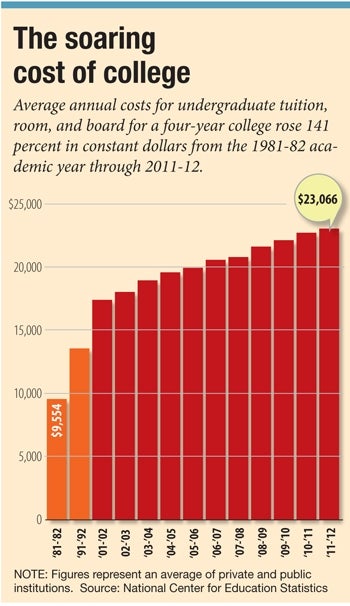Mandatory course: Cost of – and return on – tuition

Higher education, an anchor industry for Greater Worcester, is working harder today to maintain enrollments at or near current levels. As enrollment flattens, colleges and universities everywhere are realizing they must “sell” themselves better to students and their parents, who have become more discerning buyers. They want to know if the cost of an education will be worth it; that the students will be able to land jobs that will help them pay down college debt and afford a comfortable lifestyle.
This attitude has prompted higher education to engage in creative thinking, and it's starting to show up in the form of new education methods, efforts to make college more affordable, and looking outside traditional geographic boundaries to recruit students. Meanwhile, technology continues to revolutionize education at all levels. Here's what all of these spell for the year ahead.
1. Continued tuition “freezes”
One way higher education has sought to maintain enrollment is capping tuition by enacting freezes. While the long-term effectiveness of freezes is debatable, with some industry experts arguing they're not sustainable and don't necessarily drive down the total cost of education, a number of Central Massachusetts schools have jumped on this method of making college at least appear more affordable. Among them are Assumption College and Becker College, both in Worcester, as well as Nichols College in Dudley. The state university system has also offered freezes, though their ability to do so is tied to state funding.
With the growing popularity of freezing tuition, it's reasonable to expect more of the same in 2015. Mike Wasserman, executive director of Bottom Line, a nonprofit with offices in Worcester that helps low-income students pursue affordable education, said it plays into the changed mindset of incoming college students compared with those on campuses 15 years ago.
“It's not just about chasing the dream anymore, and for families, it's about making sure you don't feel guilty for taking finances into account,” Wasserman said of Bottom Line's mission.
2. More alliances between higher education and employers
This year, the Worcester Regional Chamber of Commerce hired Karen Pelletier to act as a liaison between local colleges and universities and employers. The goal is to keep more students in Greater Worcester after they graduate, as young professionals are seen as a key element in creating a vibrant city. Pelletier is working with representatives from area schools to make students aware of work opportunities that might otherwise elude them.
On the business side, area companies are beginning to partner with schools in both Worcester and Boston to identify promising young talent. This is particularly true of the growing technology sector, which struggles to find students educated in the STEM (science, technology, engineering and mathematics) disciplines to fill positions. Given the competition, expect to see more companies reaching out to young prospects through research collaborations, internships and the like.
3. Leadership changes
Education leadership is going through a period of transition, with many area schools bidding farewell to longtime administrators in 2014 and preparing to welcome their successors. Perhaps the most notable changing of the guard occurred when Worcester Polytechnic Institute hired Laurie Leshin, a NASA scientist and geochemist, who was inaugurated in November. Leshin is WPI's first female president and will no doubt be closely watched in her first full year on the job in 2015.
Meanwhile, Fitchburg State University is turning to Richard S. Lapidus, dean of the College of Business Administration at California Polytechnic University, to replace Robert Antonucci, who will retire in 2015 after 12 years as the school's leader. And Anna Maria College is searching for a new president after Jack Calareso left to take a similar job at St. Joseph's College in Patchogue, N.Y. (Mary Lou Retelle, executive vice president at Anna Maria, is serving as interim president.)
4. More creativity in offerings, recruitment
College credit for life experience? We can do that. That was Becker College's announcement in November, when it launched an online undergraduate business degree program that grants students credit for prior work and life experience.
Colleges and universities are clearly getting creative to attract a broader range of students. The life experience credit at Becker is joined by a growing number of online offerings in Central Massachusetts and elsewhere, and a new partnership between Fitchburg State and the University of Massachusetts School of Law that allows students to substitute their senior year for their first year of law school, and new recruiting tactics in which schools are looking outside traditional territories to grow their pools of potential students.
5. Mobile app adoption
The mobile software industry is seizing on every opportunity to design and sell apps for school use, and not just for classroom learning. Mobile apps are also being tested to address social and safety issues, such as bullying and the potential for in-school violence. A number of Massachusetts school districts, including the Milford Public Schools, have implemented a safety app that allows administrators and teachers to reach emergency responders through the touch of a cellphone screen. That and other similar apps, developed by local company Rave Mobile Safety, are gaining popularity at public schools, colleges and universities across the U.S. Meanwhile, public school districts are using mobile apps to communicate with parents in real time in lieu of traditional notices and newsletters.













0 Comments